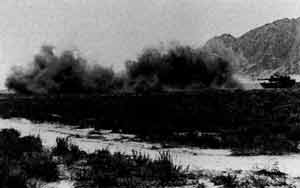| Designation: | M76 |
 |
|---|---|---|
| Manufacturer: | Tracor Aerospace, Expendables Division | |
| Product type: | Screen Laying Systems | |
| Name: | Smoke grenade |
In the 1970s, the US Army fitted its armoured vehicles with 66 mm smoke grenade launchers which fire the standard British Royal Ordnance L8 red phosphorus smoke grenade.
The launchers are designated the M239, M243, M250, M257 and M259 and vehicle types include the M1/M1A1/M1A2, M2/M3, M113A3, M981 FISTV, members of the M113A1/M113A2 family of full-tracked APCs, Light Armored Vehicle (8 x 8) and M88A1 ARV.
Although the L8 (qv) provides a smoke screen that will last for about 3 minutes allowing the vehicle to redeploy to another position, it has minimal effect on threat weapons operating in the mid- or far Infra-Red (IR) regions of the electromagnetic spectrum.
The development programme for the M76 (at that time designated the XM76) started in 1979 under the Army Office of the Project Manager for Smoke/ Obscurants (PM Smoke) at Aberdeen Proving Grounds.
The prime contractor during the development of the M76 was the AAI Corporation with the US Army Chemical Research and Development Center providing the PM Smoke with engineering support.
Following extensive trials this was type classified as the M76, the first munition designed to defeat, for 45 seconds, threat weapon sensors operating in the visual through to far IR regions of the electromagnetic spectrum.
In November 1985, Tracor Aerospace was awarded the initial contract for the M76 infra-red smoke grenade, worth US$1.5 million, with first deliveries being made in 1986.
In May 1988, Tracor announced that it had been awarded a US$4.4 million add-on production contract for M76 infra-red smoke grenades. This contract was awarded by the US Army Armament, Munitions and Chemical Command and was the fourth-year increment of a US$22.6 million production contract it had been carrying out since 1985. In October 1988, Martin Electronics Inc of Perry, Florida was awarded a US$6,089 million firm fixed-price contract for 181,840 M76 smoke IR screening grenades delivered by November 1990.
In September 1991, Martin Electronics Inc was awarded a further contract valued at US$8,016,814 for the supply of 214,946 M76 smoke grenades with deliveries completed by August 1993.
The M76 grenade consists of a plastic body, which houses the grenade launch system, a safe and arm mechanism that allows detonation only when the grenade has been launched and a smoke composition.
The grenade launch system is made up of electrical contacts and an electric match mounted on a propellant. When a grenade is fired, propellant pressure is vented behind the grenade through a thin rupture disc in the propellant retainer.
The safe and arm mechanism is designed to interrupt the delay detonator, transfer lead, booster and burster explosive train by positioning the transfer lead safely out of line until the grenade functions. This transfer lead is mounted in a spring-loaded aluminium slider.
The pyrotechnic time delay is contained in an aluminium housing while the booster and the Composition A5 burster are housed in plastic. The slider assembly is moved further out of line when the grenade is inserted in the launcher tubes, which simultaneously unlocks the setback pin.
When the grenade is launched, the propellant initiates the time delay and launch acceleration causes the setback pin to move rearward, disengaging the slider. At muzzle exit, the slider moves the transfer lead into alignment with the explosive train. The delay initiates the detonator-transfer lead-booster-burster train at the prescribed range, emitting the smoke composition into an aerosol cloud.
|
||||||
|
|||||||||
 |
